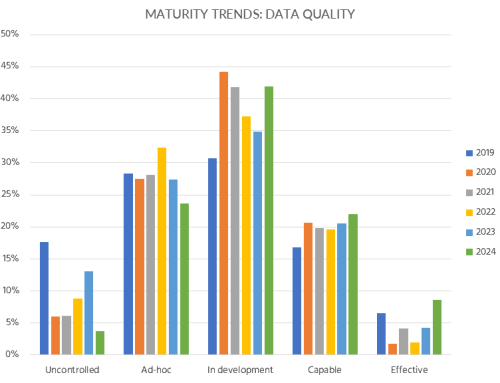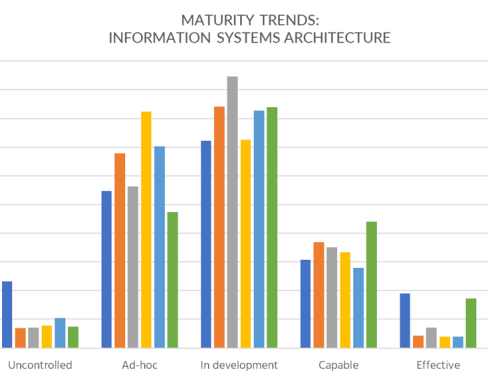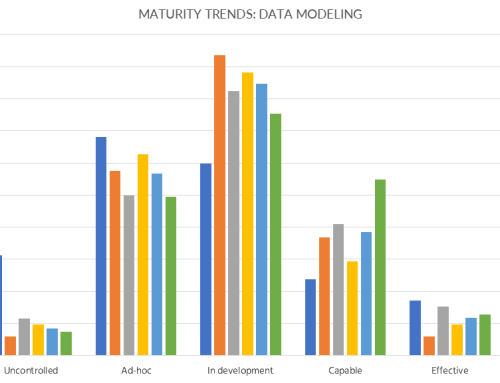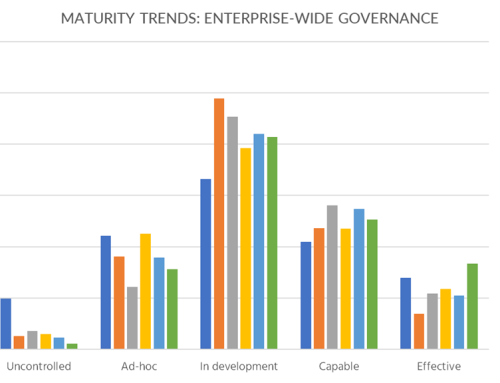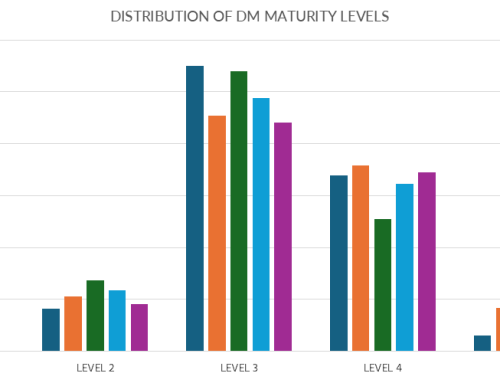This article discusses 5-year maturity trends in the data lifecycle management capability.
This is the fifth article in the series “Tracking Data Management Maturity: A Five-Year Perspective” (2019–2024).
Its purpose is to examine the evolving trends in the data chain management capability and to introduce a new approach to measuring maturity based on the outcomes of these capabilities.
In this article, we will:
- Define the data chain management capability within the context of the O.R.A.N.G.E. Data Management Framework, including its goals and key outcomes
- Highlight five-year trends in the development of this capability and its underlying components
- Provide practical recommendations for further improvement of data chain management maturity
Let’s begin by defining what data chain management entails, along with its goals and measurable outcomes.
Data Chain Management
Challenges
The key challenge with this capability is that it has not been uniquely defined across the leading industry guidelines, including DAMA-DMBOK2, DCAM®, CDMC™, and the TOGAF® Standard (see Figure 1).

Figure 1: Data chain management capability across industry guidelines.
The DAMA-DMBOK2 does not recognize data chain or data lifecycle management as a standalone Knowledge Area. Instead, it distributes responsibility for managing and enabling various stages of the data lifecycle across several Knowledge Areas—such as Data Architecture, Data Storage & Operations, Data Integration & Interoperability, and Data Warehousing & Business Intelligence
By contrast, two guidance frameworks from the EDM Association offer more focused approaches. DCAM® 3.0 outlines several high-level capabilities that support lifecycle and chain-related practices, while CDMC™ introduces a dedicated capability specifically for data lifecycle management.
The TOGAF® Standard, as a leading enterprise architecture framework, contributes through its definitions of information systems architecture, encompassing both data and applications. These architectural artifacts serve as enablers for data lifecycle and chain across the enterprise.
Definition
The O.R.A.N.G.E. Data Management Framework applies the following definition of the data chain management:
Data chain management is a company’s ability to design and maintain a data lifecycle model, to design, implement, and explore data chains, and to document data lineage.
The O.R.A.N.G.E. Data Management Framework recognizes data lifecycle management as the core value-delivery capability within the overall data management landscape, as illustrated in Figure 2. However, it is essential to understand that the effectiveness of this core capability depends on the combined support of all other data management capabilities. Together, they enable the design, execution, and governance of the data lifecycle across the organization.

Figure 2: The Data Management Capability Map.
Data Chain Management: Purpose, Outcomes, and Capability Components
The purpose of a capability represents its high-level aspiration—it answers the question: “Why does this capability exist?” It is stable over time and cannot be directly measured.
For the data chain management, the purpose can be defined as follows:
Establish enterprise-wide transparency and control over how data flows across systems and processes by managing its lifecycle, ensuring traceability, and aligning data use with business needs.
To assess whether this purpose is being fulfilled, we rely on outcomes—measurable results that demonstrate progress toward the purpose. Outcomes answer the question: “What measurable result indicates success?”
Examples of outcomes for the above purpose include:
- Increased Business Trust in Data
Business users gain confidence in the data they use because its origin, movement, and transformations are fully traceable. This transparency enables more informed and accountable decision-making.
- Improved Regulatory and Risk Compliance
By documenting the entire data lifecycle and lineage, the organization can meet regulatory requirements and conduct audits with ease. This reduces compliance risks and supports responsible data use..
- Optimized Data Value Chains and Operational Efficiency
Well-designed and governed data chains ensure that data flows efficiently from source to consumer. As a result, the organization eliminates redundancy, reduces delays, and increases the business value of data.
Although the capability defines what the organization must do, practitioners also need to understand how, when, and where it should be done. Seven components that enable each business capability not only support measurement—they also operationalize the capability into a functioning business discipline.
Figure 3 illustrates these components and shows how they link to the overall governance capability.

Figure 3: Approach to operationalizing the data chain management capability.
Designing the data chain & chain capability starts with a clear definition of its purpose—the strategic aspiration it aims to fulfill. Progress toward that purpose is measured through outcomes, which reflect whether the intended value is being delivered.
Each outcome is supported by one or more outputs—the concrete deliverables that signal progress. These outputs result from processes that act on specific inputs, forming the operational core of the capability.
To enable this flow, several components must be in place: regulations to guide activity, roles to carry it out, IT tools for automation, and other supporting assets. While these elements don’t produce outcomes directly, they ensure consistent execution—allowing outputs to be delivered and outcomes achieved.
With this structure in mind, let’s examine how the data modelling capability has evolved over the past five years.
Data Chain Management Capability: 5-Year Trends
As illustrated in Figure 4, from 2019 to 2024, organizations have made clear progress in maturing their data chain management capability.

Figure 4: Trends in developing the data chain management capability.
The proportion of organizations at the “in development” level reached its peak in 2022, surpassing half of all respondents, and has since declined to roughly one-third in 2024, signaling a shift toward greater maturity. In 2024, more than one in four organizations reached the “capable” level, and just over one in ten achieved “effective” maturity—both representing the highest levels observed in the six-year period. At the same time, reliance on “uncontrolled” and “ad-hoc” approaches has declined significantly, pointing to broader adoption of structured data lifecycle and lineage practices. Together, these trends reflect a steady, though not uniform, transition from fragmented efforts to more formalized and effective data chain management across the industry. Let me demonstrate the trends in their development.
Indicator 1: Documented Data Value Chains
This indicator helps assess how effectively an organization maps and maintains documentation of the full data flow that delivers business value. Figure 5 illustrates the maturity trends for this indicator.

Figure 5: Trends for the indicator “Documented Data Value Chains.”
The trend for Indicator 1 shows a gradual decline in the proportion of organizations at the “in development” stage—falling from just over two out of five in 2021 to roughly one in three by 2024—signaling a shift toward more advanced maturity levels. The number of organizations rated as “capable” has increased steadily, reaching nearly one in three by 2024. Meanwhile, those assessed as “effective” have also grown, now representing just over one in ten. At the same time, the shares of organizations at the “uncontrolled” and “ad-hoc” stages have either declined or stabilized. Together, these patterns point to a broader shift across the industry toward more structured and consistent documentation of data chains using dedicated tools.
Indicator 2: Ability to find and include new data
This indicator helps measure how effectively an organization identifies, accesses, and integrates new data sources into its existing data landscape. Figure 6 presents the maturity trend for this area.

Figure 6: Trends for the indicator “Ability to find and include new data.”
The results show a clear shift from lower to higher maturity levels in how organizations approach sourcing and incorporating new data. The proportion of those operating at the “capable” level has increased steadily over time, reaching close to one in three by 2024. The number of organizations at the “effective” level has more than doubled compared to earlier years, highlighting notable progress. At the same time, the shares of those at the “ad-hoc” and “in development” levels have declined, suggesting that more organizations are moving away from reactive or informal practices. Overall, the trend reflects growing maturity in how new data sources are proactively identified and integrated into enterprise data landscapes.
Indicator 3: Ability to follow and explain data transformations

Figure 7: Trends for the indicator “Ability to follow and explain data transformations.”
This indicator helps assess how well an organization can trace and explain changes made to data throughout its lifecycle. Figure 7 highlights the maturity trend for this capability.
Between 2020 and 2024, the proportion of organizations at the “in development” stage for this capability gradually declined—from just under half in 2022 to roughly one in three by 2024—indicating progress toward higher maturity. The share of those at the “capable” level has grown steadily, now exceeding one in five, while the “effective” group has reached its highest point in five years, representing approximately one in six organizations. In parallel, the “ad-hoc” and “uncontrolled” categories show a slow but consistent decline. These developments suggest that more organizations are formalizing their ability to track data transformations, though many still fall short of achieving complete control.
Indicator 4: Ability to coordinate the activities of data chain stakeholders
This indicator helps measure how successfully an organization aligns and manages collaboration among all stakeholders involved in managing data chains. Figure 8 illustrates the maturity trend in this area.

Figure 8: Trends for the indicator “Ability to coordinate data chain stakeholders.”
The trend reflects a gradual transition from fragmented collaboration toward more structured and coordinated stakeholder engagement. The proportion of organizations at the “capable” level has risen steadily, reaching its highest point in five years by 2024. Similarly, the share of those in the “effective” category has grown, now representing just over one in ten organizations. Meanwhile, the presence of “ad-hoc” and “in development” levels has declined. These developments indicate that more organizations are making progress in aligning roles and responsibilities across departments involved in data chain management.
Summary and Recommendations
The O.R.A.N.G.E. Data Management Framework applies a capability-based structure to assess and develop data chain management maturity—linking the capability’s strategic purpose to its expected outcomes, tangible outputs, and the supporting components required for effective execution.
Maturity trends from 2019 to 2024 demonstrate steady progress, as organizations move away from fragmented data flows and toward more structured lifecycle management and lineage documentation. While formal practices for documenting end-to-end data flows and integrating new data sources are becoming more common, significant room for improvement remains—especially in aligning stakeholder collaboration and achieving full traceability of data transformations.
To advance the development of the data chain management capability, an organization should:
- Define clear outcomes linked to business value
Clarify how data chain management contributes to decision-making, compliance, and operational efficiency by aligning data flows with business processes and goals. - Design and formalize the data lifecycle model
Establish a consistent framework for managing data creation, transformation, usage, retention, and disposal—forming the foundation for all data chain activities. - Implement tools for lineage and traceability
Leverage technology to track how data is transformed and consumed across systems, supporting compliance, trust, and impact analysis. - Coordinate stakeholder roles and responsibilities
Align data chain-related activities across departments by defining roles, assigning ownership, and promoting cross-functional collaboration. - Assess capability maturity and drive continuous improvement
Apply structured indicators and capability-specific KPIs to monitor progress, identify bottlenecks, and inform the ongoing development of data chain practices.


